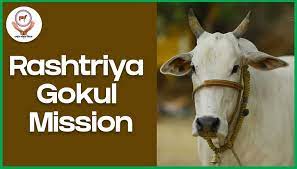17 Nov 2021 Rashtriya Gokul Mission

- Recently a review meeting was held on the performance of ‘Rashtriya Gokul Mission’.
What is ‘Rashtriya Gokul Mission’?
- The ‘Rashtriya Gokul Mission’ was launched by the government in the year 2014 under the National Program for Bovine Breeding and Dairy Development (NPBBD) for the conservation and development of indigenous breeds of milch animals.
Major objectives of the mission:
- Development and conservation of indigenous breeds of milch animals.
- Breed improvement program for indigenous animals. With this, genetic improvement in animals and increase in the number of animals will be possible.
- Efforts to increase milk production and productivity.
- Upgradation of other breeds through Sahiwal, Rathi, Deuni, Tharparkar, Red Sindhi and other elite indigenous breeds.
- Distribution of bulls of high genetic merit for natural service.
Implementation of the plan:
- Rashtriya Gokul Mission is implemented through institutions like State Livestock Development Boards.
- The State Gauseva Commission has been ordered to sponsor the proposal of ‘Livestock Development Board’ under the ‘State Implementing Agency-SIA’ and monitor these sponsored proposals.
- Agencies such as CCBF, Indian Council of Agricultural Research, Agricultural or Animal Husbandry universities, colleges, NGOs, cooperatives and gaushalas are the participating agencies, including the best germplasm in the indigenous animal department.
What is ‘Gokul Gram’?
- Gokul Gram Indigenous Animal Center and ACT are working as a center for the development of indigenous breeds.
- Funds for this scheme are given for the establishment of Integrated Indigenous Animal Centre, Gokul Gram.
- Gokul Grams are established in the metropolitan areas near the native breeding areas and cattle for urban housing.
Role and Responsibilities of Gokul Gram:
- A reliable source for supplying high genetic breeding stock to the farmers in the breeding area of cows. Gokul Gram gives modern facilities in training center for farmers.
- In these Gokul villages with a capacity of 1000 animals, the ratio of milk producing and non-productive animals is 60:40.
- Gokul Grams are made for domestic production of fodder to meet the nutritional needs of the animals.
- Gokul Gram is actually developed on the lines of an economic institution, in which economic resources are being generated through the sale of following items: Milk Organic Manure Earthworm Manure Urine Distillate Electricity Generation from Bio Gas for Domestic Consumption Animals sales of products etc.
- Focus will be on genetic upgradation of urban cattle in metropolitan Gokul village.


No Comments